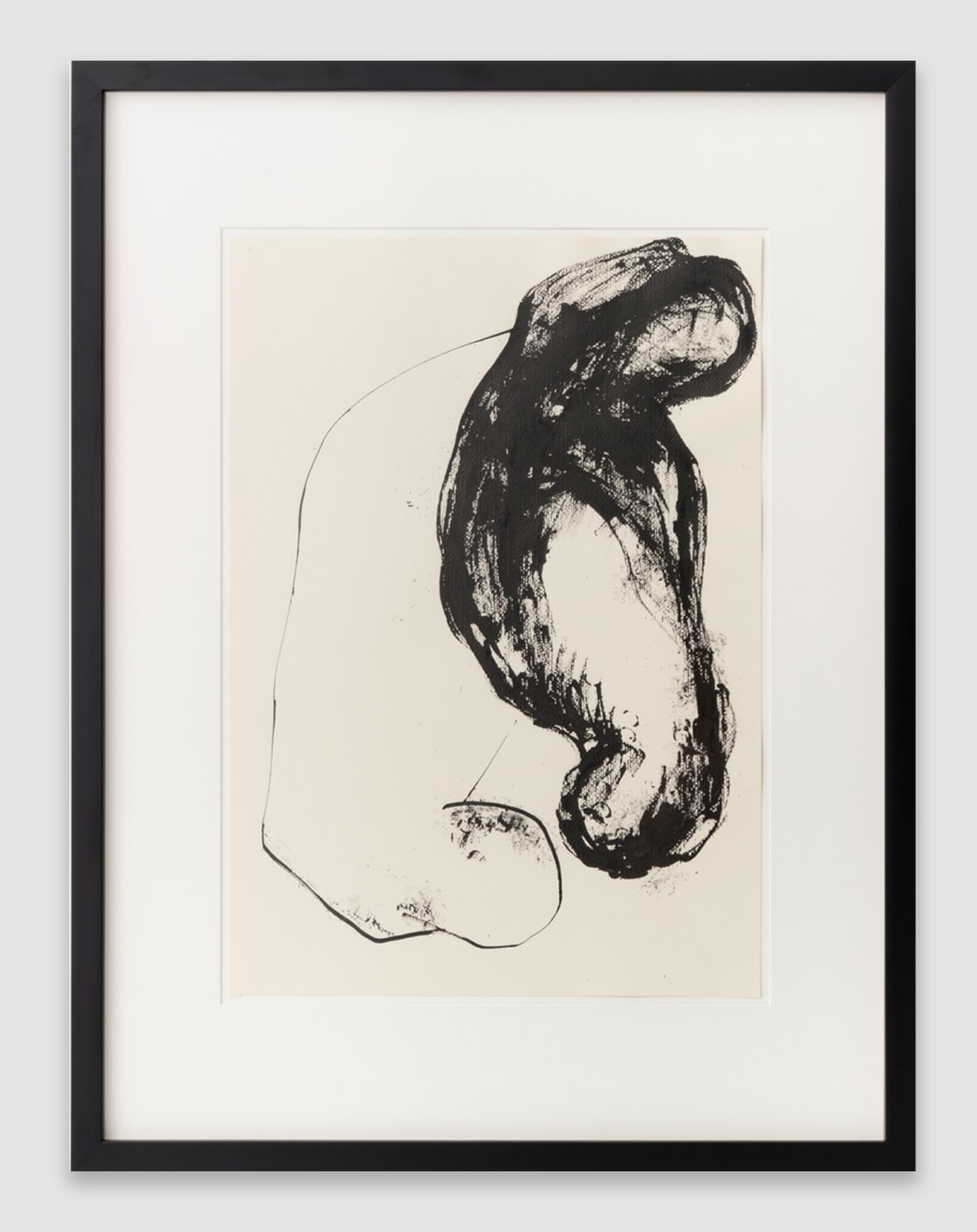Botond Részegh
Weekdays, 2020
Ink on paper, framed
28 1/2 x 21 3/4 x 1 in
72.4 x 55.2 x 2.5 cm
72.4 x 55.2 x 2.5 cm
RB0033
Copyright The Artist
Plus d'images
Infused with explosive energy and visceral rawness, Részegh’s paintings simultaneously invoke poetry, history, literature, metaphysics and the artist’s own contemporary experience. His pictorial language is distinguished by an idiosyncratic vocabulary...
Infused with explosive energy and visceral rawness, Részegh’s paintings simultaneously invoke poetry, history, literature, metaphysics and the artist’s own contemporary experience. His pictorial language is distinguished by an idiosyncratic vocabulary of figurative forms and gestural lines. Repeating motifs of solitary figures, anatomical structures and distorted bodies in motion, rendered in bold, rough brushwork, swell with emotion and rigor.
At the center of Részegh’s work is an isolated human being: a marooned soul, helplessly wandering through a disintegrated landscape who desperately seeks basic necessities for human survival. Részegh pictures a fallible human being who experiences suffering, agony and fear, but can also be portrayed as unique and magnificent. In stark contrast to the lone figures in his other works, Részegh explores togetherness in the ongoing series Weekdays Wrapped Up, started during COVID quarantine in 2020, when the artist and his family were confined to a 38 sq meter (410 sq ft) apartment.
Részegh draws inspiration from literature, art history and philosophy: a wall in his studio is adorned by portraits of influential artists and literary figures, including Fyodor Dostoevsky, Oscar Wilde and Rainer Maria Rilke. While developing an artistic language that is unmistakably contemporary and entirely his own, Részegh grounded himself in the tradition that began with Leonardo Da Vinci and Rembrandt and extended through Francis Bacon, Cy Twombly, Alberto Burri into the spare and expressive figuration by Susan Rothenberg. His engagement with art historical influences is rich and varied. The unostentatious simplicity in Christian Orthodox icon paintings and the meticulousness in ancient Greek vases captivated Részegh’s imagination when he was a graphic arts student at the National University of Fine Arts in Bucharest. Upon a life-defining encounter with Dostoevsky’s novel, The Idiot, Részegh decided to become an artist. An enduring interest in literature naturally became a part of Részegh’s creative process, although there has never been a direct literary transcription in his paintings. Writings by acclaimed contemporary poets and novelists in Romania and Hungary often accompany Részegh’s publications. Viewing Részegh’s arresting work demands time and contemplation. More than simply a reflection of the artist’s inner state of mind, the work asks the viewer to be aware of their own thoughts and to engage freely and imaginatively beneath the tactility of the painted surface.
Born in Romania in 1977, Botond Részegh currently lives and works in Miercurea Ciuc, Romania and Budapest, Hungary. Részegh has exhibited internationally at venues such as the Art Museum Cluj Napoca, The National Museum of Art of Romania, The Museum of Art Timisoara, the Viltin Gallery Budapest, the Hungarian Cultural Institute in Rome and the Romanian Culture Institute in Vienna. His work belongs in the collections of Pope Francis, Northeastern University and the Art Museum of Prahova, among others. Részegh graduated from the National University of Fine Arts in Bucharest, where he specialized in graphic arts. He also attended a doctoral program at the Hungarian University of Fine Arts in Budapest.
At the center of Részegh’s work is an isolated human being: a marooned soul, helplessly wandering through a disintegrated landscape who desperately seeks basic necessities for human survival. Részegh pictures a fallible human being who experiences suffering, agony and fear, but can also be portrayed as unique and magnificent. In stark contrast to the lone figures in his other works, Részegh explores togetherness in the ongoing series Weekdays Wrapped Up, started during COVID quarantine in 2020, when the artist and his family were confined to a 38 sq meter (410 sq ft) apartment.
Részegh draws inspiration from literature, art history and philosophy: a wall in his studio is adorned by portraits of influential artists and literary figures, including Fyodor Dostoevsky, Oscar Wilde and Rainer Maria Rilke. While developing an artistic language that is unmistakably contemporary and entirely his own, Részegh grounded himself in the tradition that began with Leonardo Da Vinci and Rembrandt and extended through Francis Bacon, Cy Twombly, Alberto Burri into the spare and expressive figuration by Susan Rothenberg. His engagement with art historical influences is rich and varied. The unostentatious simplicity in Christian Orthodox icon paintings and the meticulousness in ancient Greek vases captivated Részegh’s imagination when he was a graphic arts student at the National University of Fine Arts in Bucharest. Upon a life-defining encounter with Dostoevsky’s novel, The Idiot, Részegh decided to become an artist. An enduring interest in literature naturally became a part of Részegh’s creative process, although there has never been a direct literary transcription in his paintings. Writings by acclaimed contemporary poets and novelists in Romania and Hungary often accompany Részegh’s publications. Viewing Részegh’s arresting work demands time and contemplation. More than simply a reflection of the artist’s inner state of mind, the work asks the viewer to be aware of their own thoughts and to engage freely and imaginatively beneath the tactility of the painted surface.
Born in Romania in 1977, Botond Részegh currently lives and works in Miercurea Ciuc, Romania and Budapest, Hungary. Részegh has exhibited internationally at venues such as the Art Museum Cluj Napoca, The National Museum of Art of Romania, The Museum of Art Timisoara, the Viltin Gallery Budapest, the Hungarian Cultural Institute in Rome and the Romanian Culture Institute in Vienna. His work belongs in the collections of Pope Francis, Northeastern University and the Art Museum of Prahova, among others. Részegh graduated from the National University of Fine Arts in Bucharest, where he specialized in graphic arts. He also attended a doctoral program at the Hungarian University of Fine Arts in Budapest.









